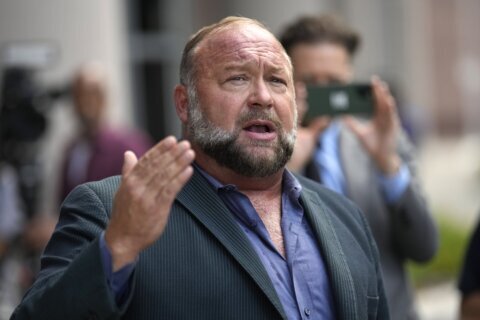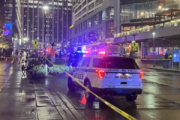LOUISVILLE, Ky. (AP) — Federal prosecutors told a jury Wednesday that a former Louisville police detective’s actions were like “a drive-by shooting” when he fired 10 bullets into the side of Breonna Taylor’s apartment the night she was shot to death by police.
That former detective, Brett Hankison, couldn’t see what he was shooting at the night of the 2020 raid, prosecutors argued during closing statements in Hankison’s federal retrial. A jury of six men and six women began deliberating in the afternoon on two charges that Hankison’s shots violated the civil rights of Taylor and her neighbors. The felony charges carry a maximum sentence of life in prison if Hankison is convicted.
Hankison’s federal trial last year ended in a mistrial when a jury deadlocked after failing to reach a verdict. He was acquitted in a 2022 in a state trial on wanton endangerment charges.
Hankison, 48, began firing after a fellow officer was struck by a bullet shot by Taylor’s boyfriend, who was inside the apartment. Officers returned fire at the door, killing Taylor. As the shooting started, Hankison went away from the door, rounded a corner and fired a volley of shots into Taylor’s sliding glass door and a window.
“The defendant violated one of the most fundamental rules of deadly force, if they cannot see the person they’re shooting at, they cannot pull the trigger,” Assistant U.S. Attorney Michael Songer argued during his closing statement. Several officers and Louisville Police Chief Paul Humphrey testified during the case that officers shouldn’t fire without being able to identify a target.
Hankison’s shots didn’t hit anyone, though they flew into a neighbor’s apartment, nearly striking two people inside.
Songer said Hankison fired into opposite ends of the apartment unit “immediately, one after the other, like a drive-by shooting.”
But Hankison’s attorneys painted a different picture of the night of Taylor’s death, which prompted months of protests over police brutality in 2020.
They said Hankison was acting to save his fellow officers “in a very tense, very chaotic” situation that lasted about 12 seconds.
His lawyers emphasized that Hankison was volunteering that night to help out with the raid, that officers were not told by their lookout that there was more than one person in Taylor’s apartment, and they weren’t aware that Taylor’s apartment shared a wall with another apartment behind it.
“This case is about Brett Hankison’s 10 shots that never hit anyone,” his attorney, Don Malarcik, said during his closing arguments. “Brett Hankison is charged with violating the constitutional rights of people he never met and never knew existed.”
Hankison testified earlier this week that he believed a person armed with an AR-15 was firing at officers from inside the apartment, and he moved to get out of the way and return fire at the sight of muzzle flashes through the glass door and window on the side of the apartment unit. Another officer said in testimony earlier in the week that the shots were the loudest he has ever heard.
But Taylor’s boyfriend, Kenneth Walker, had a handgun, not a rifle, and he fired a single shot that struck former Sgt. Jonathan Mattingly in the leg. Mattingly and another officer at the door returned 22 shots, some of them striking Taylor. Malarcik said Mattingly was hit in the femoral artery, and he was 90 seconds away from dying before other officers treated him at the scene.
Hankison “did exactly what he was supposed to do,” Malarcik said. “He was acting to save lives.”
Mattingly testified earlier this week that he saw a person holding a gun at the end of the hallway before he was shot. Walker later told police he thought an intruder was breaking in when police broke down the door.
Hankison was one of four officers who were charged by the U.S. Department of Justice in 2022 with violating Taylor’s civil rights. The two counts against him carry a maximum penalty of life in prison if he is convicted. The three other former officers charged were involved in crafting the search warrant.
Copyright © 2024 The Associated Press. All rights reserved. This material may not be published, broadcast, written or redistributed.







